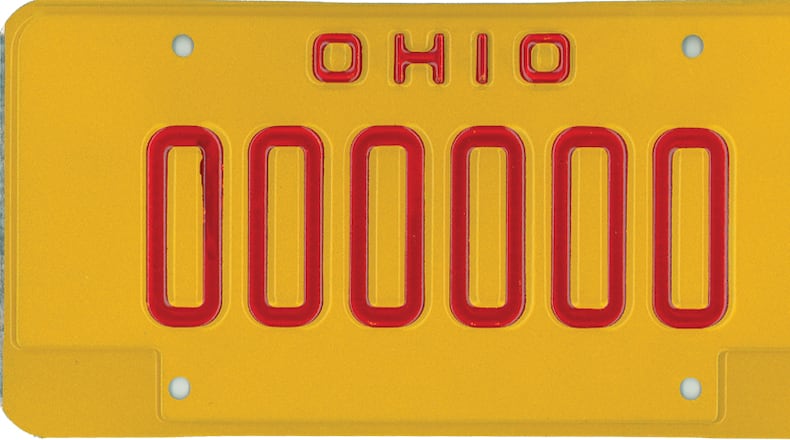Critics said requiring drivers to display party plates is an unfair punishment, especially considering people convicted of more serious crimes aren’t required to advertise their crimes for the purpose of public shaming.
“The thing that bothers me the most is the arbitrariness of the party plates, because we don’t have them for anything else, and we’re the only state that does it,” said Charles Rowland, a defense attorney with DaytonDUI.com.
But supporters say they the plates are useful because they alert law enforcement and other motorists that the vehicles belong to someone with a history of drunk driving and may deserve extra scrutiny.
MORE: Ohio Highway Patrol video shows drunk driving over a 24-hour period
Ohio is one of just a couple of states that require motorists convicted of certain drunken driving offenses to get special license plates.
Ohio’s restricted plates, also nicknamed party plates, always were intended to be a “Scarlet letter” to deter people from drinking and driving with the threat of public embarrassment, while also signaling to law enforcement that these vehicles may deserve extra attention, local attorneys say. No other state has anything like Ohio’s party plates.
Last year, the Ohio Bureau of Motor Vehicles recorded 3,273 transactions across the state involving restricted license plates.
Transactions were down about 14% from 2018, and 55 of Ohio’s 88 counties saw decreases in restricted plate issuances, exchanges, renewals, replacements and transfers.
Last year, about 246 party plate transactions took place in Butler, Champaign, Clark, Greene, Miami, Montgomery and Warren counties, which was an 11% decline from 2018, state data show. Miami and Warren counties saw transactions increase.
MORE: Millennials and new arrivals are upbeat on Dayton. But will they stay?
Prior to that, judges were allowed to order convicted drunken drivers to display party plates, but the change made the plates mandatory for some repeat violators and certain offenses, says Cincinnati law firm Luftman, Heck & Associates LLP.
Courts can grant limited driving privileges so people with suspended licenses can get to work, school, medical appointments and other activities deemed essential.
Motorists may have to display the plates for between six months to three years, until their drivers licenses are fully reinstated, Luftman, Heck & Associates says.
The plates can lead to discrimination and other negative consequences from potential employers and other community members, and vehicles with party plates may be targeted for police stops, the firm said. Judges have the discretion to order restricted plates as a condition of limited driving privileges after an OVI or an administrative license suspension.
But the decline in plate transactions likely can be attributed to the fact that it is becoming less common for people arrested for drunken driving offenses to have subsequent offenses, said Rowland.
MORE: Some Oregon District survivors have PTSD. Cops aren’t immune either
Years ago, law enforcement used to focus drunken driving enforcement on substantially intoxicated drivers, but more recently they have cracked down on drivers who test just barely over the legal limit, Rowland said.
These drivers are much less likely to drink and drive again after an arrest, especially after they go through the 72-hour driver intervention program, Rowland said.
Most people convicted of drunken driving have to attend a three-day weekend intervention program or go to jail, and obviously most choose the program, which focuses on decision making, harm reduction and teaching empathy, he said.
Rowland said the program is extremely effective at reducing recidivism.
Rowland says he opposes party plates because it’s not fair that only drunken driving offenders are saddled with a Scarlet letter, or a badge of shame.
He questioned why there aren’t plates for repeat speeders, reckless operators, road rage offenders, child molesters and murderers.
Other lawyers say attitudes about party plates and shaming drunken drivers might be changing.
Judges certainly care strongly about drunken driving, but they seem to prefer to have the discretion to punish offenders based on the individual case and specific facts and circumstances, said Daniel Allnutt, a partner with Casper & Casper, which has offices in Dayton, Middletown, Hamilton and Cincinnati.
“Perhaps we also don’t see ‘party plates’ as often because it seems most judges/courts have come to grips with the fact that if someone has a real substance abuse issue, simply shaming them with a bright colored plate is not going to solve the problem,” he said.
Mothers Against Drunk Driving Ohio say interlocking devices are the best way to prevent drunken driving, but the plates may help law enforcement easily identify repeat drunk drivers.
“Party plates do not stop any one from driving drunk,” the group said. “We feel that the party place is not shaming, but a form of notification.”
Party plate transactions in Ohio
County, 2018, 2019
Butler, 95, 83
Champaign, 17, 11
Clark, 33, 29
Greene, 24, 18
Miami, 21, 25
Montgomery, 52, 42
Warren, 35, 38
About the Author

